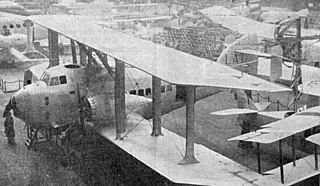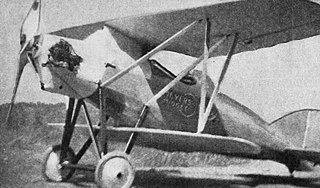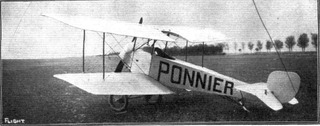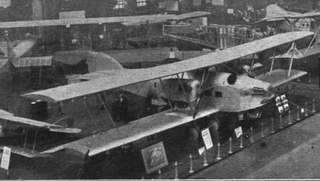| L.71 | |
|---|---|
 | |
| Role | Two seat light biplane |
| National origin | Germany |
| Manufacturer | Albatros Flugzeugwerke |
| First flight | 1925 |
| Number built | 2 |
The Albatros L.71 was a two-seat, single pusher engined biplane built in Germany in the 1920s.
| L.71 | |
|---|---|
 | |
| Role | Two seat light biplane |
| National origin | Germany |
| Manufacturer | Albatros Flugzeugwerke |
| First flight | 1925 |
| Number built | 2 |
The Albatros L.71 was a two-seat, single pusher engined biplane built in Germany in the 1920s.

Flight described the L.71 [note 1] as a flying boat on wheels because, in the 1920s, such aircraft were almost the only modern pusher biplanes. Visually, the most unusual feature was the extreme stagger, introduced to optimise the view for each of the occupants of its tandem cockpits. Both wings had spruce spars, continuous from tip to tip, and spruce ribs. The larger upper wing had no dihedral but carried the ailerons; the lower wing had 1.5° of dihedral. Outward leaning, aluminium tube N-form interplane struts braced the wings but there was none of the usual flying wire bracing in the single bay; the wings were aerodynamically quite thick, allowing them to be internally braced cantilevers. The upper wing centre section was supported by a shorter pair of outward leaning N struts from the upper fuselage. Though the lower plane was set at mid-fuselage the interplane gap was large, to provide clearance for the two blade propeller. [1]
The pusher configuration 55 hp (41 kW) Siemens-Halske Sh 10 [2] five cylinder radial was aerodynamically faired into the upper wing trailing edge but was not structurally connected to it; instead, four tubes from the fuselage formed the engine mounting. The fuel tank was within the forward section of the upper wing, feeding the engine by gravity with some pressure assistance. The fuselage was of mixed construction. From the nose to the lower wing leading edge, a region which included the two cockpits, it was a flat sided wooden structure, covered in plywood; aft, it was built from wire braced, welded steel tubes and fabric covering. This section included the lower wing mounting. The tail surfaces were fabric covered, over mixed steel and duraluminum frames. The incidence of the tailplane could be adjusted for pitch trimming. The L.71 had a simple, fixed conventional undercarriage with short axles hinged to the lower fuselage longerons and forward braced with short horizontal struts. Sprung, telescopic legs with rubber shock absorbers were attached to the outer end of the axles and to the upper fuselage longerons. [1]
The L.71 was flight testing by late January 1926. [1] Two were built. [2]

Data from Flight, 28 January 1926 [1]
General characteristics
Performance

The Latécoère 4 was a three-engined, 15-passenger biplane built in France in the early 1920s. It proved difficult to fly and was discontinued, though a second machine was completed as the Latécoère 5 bomber.

The Meyers Midget was a one-off small, low-powered, sporting single-seat sesquiplane, designed and built in the United States in 1926, incorporating several innovative structural features.

The Siemens-Schuckert DDr.I was a World War I German twin engine, push-pull configuration triplane fighter aircraft. Only one was built, crashing on its first flight.
The Gabardini biplane was an Italian single seat biplane, designed and built near the beginning of World War I. It was an advanced trainer and could be fitted with engines of output between about 40 to 80 kW.

The NVI F.K.35 or Koolhoven F.K.35 was a two-seat fighter aircraft built in the Netherlands during 1926. It was completed and exhibited but, through a combination of ground accident and financial problems, never flown.

The Ponnier L.1 was an early French biplane single seat scout, built just before World War I. It did not reach production.
The Siemens-Schuckert B was an unarmed German two seat reconnaissance biplane built early in World War I. A single example was delivered but soon lost.

The Potez XVIII was a French airliner from the early 1920s, a three-engine biplane carrying up to twelve passengers.
The Potez 27 was a French reconnaissance biplane first flown in 1924. 175 were operated by the Polish Air Force, most built in Poland by PWS under licence. Others went to Romania, where they were also used as light bombers.

The Caudron C.74 was a ten-seat, four engine passenger biplane built in France in 1922. It showed promise but the sole prototype crashed fatally in a competition and no more were completed.

The Caudron Type L was a two-seat French pusher configuration amphibious biplane, flown around 1913 and intended for naval use.

The Feiro Dongó was a Hungarian side-by-side trainer biplane. It was notable for its high aspect ratio wings, aerodynamic cleaness and high lift/drag ratio.

The Heinkel HD 20 was a twin engine, three seat German biplane built in 1926 for civil survey work.
The Latham E-5 was a large French Naval four engine biplane flying boat, flown in 1925. It was successfully tested but only one was built.

The Morane-Saulnier MS.350 was a French aerobatic trainer flown in 1936. Only one was built but it had a long career, flying post-war until the 1960s.
The Caproni Ca.61 was an Italian heavy day bomber aircraft of 1922. It was the final development of the Caproni three engine, twin boom biplane types developed during World War I, but it was not put into production.
The Caproni Ca.66 was an Italian night bomber designed to reequip the post-World War I Italian Air Force. Only two examples of the four-engined biplane were built.

The Aerial Engineering Corporation Standard 6W-3 was a commercial transport modification of the US Standard J-1 biplane military trainer aircraft, with new wings, engine and accommodation for four passengers. First flown in 1925, it was built in small numbers.

The Schneider Henri-Paul was a French four-engined night bomber with an all-metal airframe. A single example was built and flown in 1922.
The LFG V 8 Bärbel (Barbel) in English) was a small, single-engined, biplane flying boat which carried two passengers. The sole example was built in Germany shortly after World War I but was exported and used for Baltic flights.
| Wikimedia Commons has media related to Albatros L.71 . |